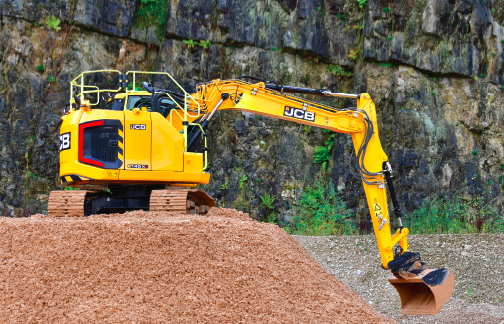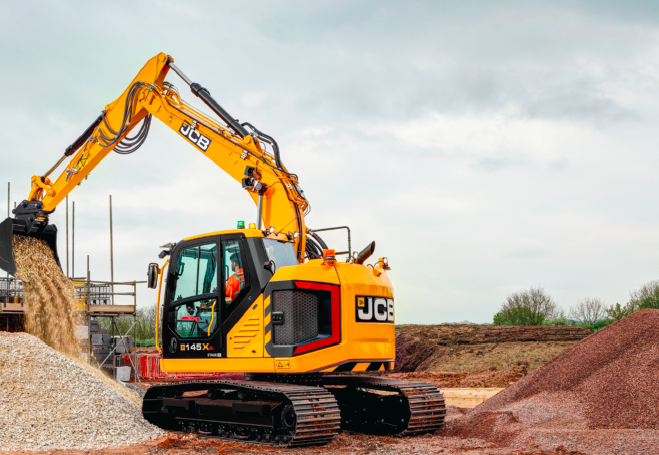
With an in-depth product test, the JCB 145XR reduced tailswing crawler excavator swings into action!
JCB’s X-Series of crawler excavators has been a major success for the company, eclipsing the performance and productivity of the previous generation JS models and gaining new customers across the country. Initially launched in popular 220X form, the 22-tonner was soon joined by the 131X, 140X and 150X, competing in the all-important 13-15 tonne sector. JCB’s first reduced tailswing X-Series model was the 245XR and this machine has now been joined by a smaller stablemate, in the all-new 145XR. Offering a 27% shorter tailswing than the popular 140X conventional model, the 145XR actually boasts the same dig end, bucket ram and undercarriage as the larger 150X, providing stability and lifting capability.
The machine is offered with a choice of a monoboom, or a two-piece triple articulating boom (TAB). The TAB boom provides a 15.5% reduction in the total working envelope, matching a reduced front end swing radius with the smaller counterweight back end.
Despite that smaller turning radius, the boom manages a maximum digging depth of 6,167mm, while the monoboom and 3m dipper arm offer 6,027mm. It’s a similar story in terms of forward reach, with the TAB boom delivering a maximum of 9,230mm against the monoboom’s 8,801mm. Maximum bucket tearout force is a healthy 104.5NkN with either boom configuration.
The 145XR can be specified with an optional dozer blade, for those looking for ultimate stability and versatility. Around 30% of UK customers will go for the dozer, with a higher percentage in Scandinavian and German markets. Unlike some competitive short radius models, the 145XR retains the full CommandPlus cab, giving it the same operator space and comfort as other XSeries models. There are a choice of seating options, right up to a fully heated and cooled air suspension model. The most noticeable feature in the cab though, is the new JCB UX user interface, with its 10” touchscreen monitor.
Launched with the much larger 370X earlier this year, the JCB UX allows up to 25 different user profiles, that operators can preset to suit the way they drive. This includes setting joystick configurations and allotting tasks to each of the buttons and rollers in the servo lever heads. A panel of hot keys makes it easy to navigate and to alter the layout of controls.
There is improved mobile phone connectivity and the machine comes with twin safety cameras as standard. A full 360° camera system is offered as an option. Operators also benefit from standard LED work lights, with option packs taking the count to as many as 14 lights around the machine. As with all XSeries models, the 145XR can be prepared in the factory for a Leica machine control system.
In operation, the compact machine is remarkably quick off the mark. It is possible to tone down the controls through the JCB UX system, but the demonstration machine was certainly keen to move. That said, the hydraulic system is incredibly smooth, with no jerkiness, even at higher engine rpm. It is also possible to fine grade with ease, working multiple boom and bucket functions together to smoothly scrape the bucket across the ground.
In typical UK monoboom and long dipper configuration, with a decent size bucket in wet material, it is possible to upset the stability of the machine when working cross track. Work within the machine’s generous capabilities however and for such a compact machine it is easy to see how productive it could be in the hands of a more experienced operator. The power behind that productivity will be familiar to JCB customers, as the firm’s Stage V Dieselmax 448 engine is located within that rounded counterweight. This 81kW (108hp) engine runs at a slower 1,700rpm, boosting fuel economy by 10% compared to the previous JZ140. With Auto-Stop and Auto-Idle, in combination with multi-mode hydraulic control, the machine delivers more than enough power, with a new level of economy.
Despite the compact dimensions, it is still possible to get to the engine and its major service points, with wide opening access doors to each side and an engine cover on top of the machine that has a sunken standing platform to make life easier for technicians. All filters can be reached from ground level and the air conditioning condenser can be pulled away from the radiator cores for easier cleaning.
The excavator sits on heavy-duty track components and there are graphite bushes on key pivot points. This leads to 250-hour greasing intervals, reducing regular downtime. Hydraulic filter changes have been extended to 2,000 hours, resulting in 24% fewer filter changes over a 10,000-hour period, further cutting operating cost for the customer. The XSeries machine also comes with a fiveyear subscription to JCB’s LiveLink telematic remote monitoring offer.
The 145XR’s reduced tailswing makes it an ideal machine for a range of applications, including working within a road carriageway. The machine will be equally at home on a tight housebuilding site, where its lifting capabilities will be of use along with its digging ability. JCB has been promoting the machine as ‘Minimum Swing, Maximum Space’. Certainly, the rear-end of the machine could hardly be more compact and, in combination with the 150X tracks, there is very little overhang when slewing. The
Maximum Space refers to the operator’s cab, which remains unchanged from the firm’s larger, conventional tailswing models, which will be welcome news for drivers. In conclusion, the 145XR has followed the successful path laid by its larger 245XR stablemate, though it will probably find even more buyers than the 25-tonne machine. With all of the durability, productivity and reliability features that have already been seen across the X-Series line-up, the 145XR deserves to do well.









